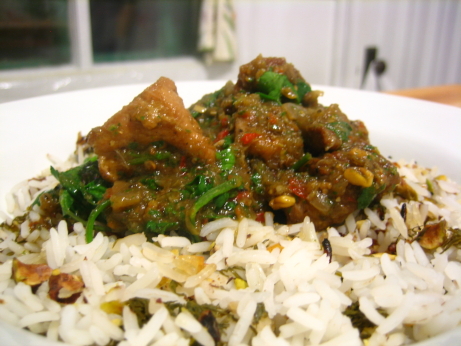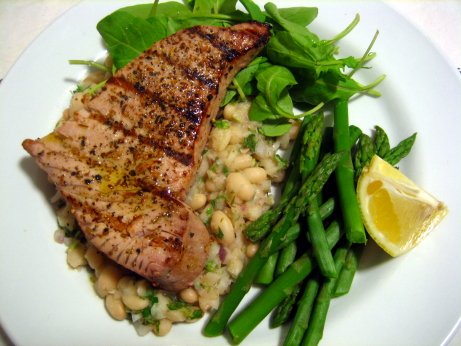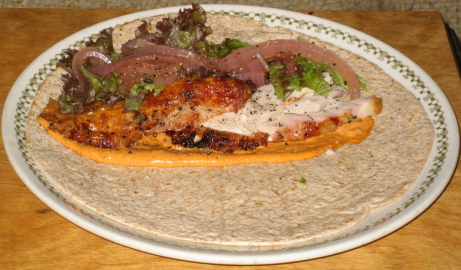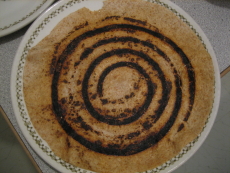The Georgian Salsa called ajika, which I blogged about last time totally blew me away. This pork stew uses a lot of the same flavours, and integrates the ajika as an important ingredient, so predictably, I like it a lot. The stew uses some unusual ingredients including summer savory, corriander seeds, fenugreek, and dried marigolds, but nothing I had too much trouble finding.
I really like it when The Book pushes my limits and asks me to try new and different things, but I simultaneously curse The Book for sending me running all over the city trying to find exotic components, and damn them for not using the unusual ingredients that I have easy access to in their recipes. They have to draw a fine line between authenticity and simplicity in designing these recipes, and no matter where they make their stand someone is going to be upset. In general I’ve got to give them credit for striking a fairly good balance, or at least what seems like a good balance to someone living in a major metropolitan centre with easy access to a specialty shops. I imagine trying to do this project in Smalltown USA with nothing but a Megamart at your disposal would be a challenge. From my perspective getting to crush up flowers and put them in my dinner was good fun, but it might be a deal breaking frustration for other cooks out there.
The method for this stew is a little bit unusual. You begin by adding cubed and seasoned pork shoulder to a covered pot without any oil, then turning the heat to high and letting the pork steam for 10 minutes, only stirring it once. I read that instruction about five times because it sounded so unsual, but it worked, the pork released juices and steamed instead of burning or sticking as I feared it would. After 10 minutes the lid is removed and the pork juices are allowed to evaporate, still over high heat. Once the liquid is gone, oil is added and the meat is sautéed until well browned. While that’s going on you make a paste of garlic, summer savory, and salt, which is added to the browned meat and cooked for a minute. You then grind corriander and fenugreek and add them along with chopped red onion, and marigold and cook for a few minutes. A cup of water is added, and stew is braised for an hour. Once the meat is tender fresh cilantro, Georgian salsa, and pepper are stirred in. The stew is served with more of the ajika on the side, and with pomegranite seeds sprinkled on top (which I never got around to).
I don’t think the steam-before-you-sear technique did good things to my pork. I can see this sort of technique working well with a really fatty and tough piece of pork shoulder, but my relatively lean supermarket pork didn’t survive the process very well. The meat gives up a lot of it’s moisture, which evaporates before the meat is browned. The expectation is that the moisture would re-penetrate the meat during braising, and that there would be enough fat in the meat to keep it moist. That didn’t happen for me, the meat gave up it’s moisture, and never really got it back. Nothing is quite as frustrating as a dish that simmered for hours, but somehow ends up dry.
Other than that fairly major complaint the dish was excellent. The flavours were absolutely spot on. The ajika is amazing, and the additional herbs really brought the dish home. The sauce was irresistible, I’m willing to admit that I went at the sauce with a spoon while pretending to put it away in the fridge. I’m convinced that a better piece of pork would have allowed this technique to work, and deliver succulent meat along with the incredible sauce. If you’re using bog-standard grocery store pork I’d recommend skipping the steaming step, browning and braising should be sufficient to tenderise the meat without driving all the moisture out.
Had the pork worked out this would be a no brainer for a five star rating. Dry pork is a fairly major flaw, so I should penalize it heavily, but all said and done I still really enjoyed this meal, and can’t bear to give it less than a



 I wonder if they tested this on a gas stove and figured it would work out for electric too? or perhaps I’m missing something. My dining companion just shook her head and sighed while she watched me fill our kitchen with smoke.
I wonder if they tested this on a gas stove and figured it would work out for electric too? or perhaps I’m missing something. My dining companion just shook her head and sighed while she watched me fill our kitchen with smoke.